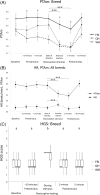Parasympathetic tone activity, heart rate, and grimace scale in conscious horses of 3 breeds before, during, and after nociceptive mechanical stimulation
- PMID: 39150630
- PMCID: PMC11423482
- DOI: 10.1111/jvim.17174
Parasympathetic tone activity, heart rate, and grimace scale in conscious horses of 3 breeds before, during, and after nociceptive mechanical stimulation
Abstract
Background: Parasympathetic tone activity (PTA) in response to nociceptive stimulus in conscious non-sedated horses is unknown.
Objectives: Study PTA, heart rate (HR), and horse grimace scale (HGS) at rest and during mechanical nociceptive stimulation.
Animals: Ninety healthy young adult horses (females, males): 30 each of Friesians, Quarter Horses, and Warmbloods.
Methods: Prospective control study. The study consisted of habituation to equipment (Day 1), baseline recordings (Days 2 and 3), and nociceptive testing applying mild pressure to the metacarpus (Day 4). Parasympathetic tone, HR, and HGS were recorded simultaneously on Days 2 to 4. Each study lasted 30 minutes and was done in triplicate at 3 different time points per day.
Results: Baseline PTA was not different among breeds. It decreased in Warmbloods and Quarter Horses during placement of the stimulus device without stimulation (P < .01). A significant decrease in PTA (P < .001) occurred during nociceptive stimulus (marked in Quarter Horses, intermediate in Warmbloods, and mild in Friesians). Heart rate and HGS increased significantly (P < .001) during the stimulus in all breeds but returned to baseline poststimulation. Friesians required higher pressure (P < .05) to elicit an aversive response to the stimulus.
Conclusions: Horses' PTA, HR, and HGS change in response to a mild mechanical nociceptive stimulus with Friesians showing less variation. Stress induced a decrease in PTA in Quarter Horses and Warmbloods but not in Friesians. Friesians appeared to be more tolerant to pain based on PTA, HR, and HGS findings compared with other breeds.
Keywords: autonomous; behavior; pain; vagal tone; welfare.
© 2024 The Author(s). Journal of Veterinary Internal Medicine published by Wiley Periodicals LLC on behalf of American College of Veterinary Internal Medicine.
Conflict of interest statement
Authors declare no conflicts of interest. We thank Drs. Alvaro Rioja and Moises Valderrama for assisting and providing the horses.
Figures



Similar articles
-
Efficacy of the Parasympathetic Tone Activity monitor to assess nociception in healthy dogs anaesthetized with propofol and sevoflurane.Vet Anaesth Analg. 2020 Jan;47(1):103-110. doi: 10.1016/j.vaa.2019.05.014. Epub 2019 Aug 27. Vet Anaesth Analg. 2020. PMID: 31635963
-
Differences in ultrasound-derived arterial wall stiffness parameters and noninvasive blood pressure between Friesian horses and Warmblood horses.J Vet Intern Med. 2020 Mar;34(2):893-901. doi: 10.1111/jvim.15705. Epub 2020 Feb 7. J Vet Intern Med. 2020. PMID: 32032455 Free PMC article.
-
Performance of the Parasympathetic Tone Activity (PTA) index to predict changes in mean arterial pressure in anaesthetized horses with different health conditions.Res Vet Sci. 2021 Oct;139:43-50. doi: 10.1016/j.rvsc.2021.07.005. Epub 2021 Jul 3. Res Vet Sci. 2021. PMID: 34246942
-
Thermal, mechanical and electrical stimuli in antinociceptive studies in standing horses: an update.Vet Anaesth Analg. 2020 Jan;47(1):15-27. doi: 10.1016/j.vaa.2019.09.003. Epub 2019 Oct 13. Vet Anaesth Analg. 2020. PMID: 31813668 Review.
-
Thermal and mechanical nociceptive threshold testing in horses: a review.Vet Anaesth Analg. 2011 Jan;38(1):3-14. doi: 10.1111/j.1467-2995.2010.00580.x. Vet Anaesth Analg. 2011. PMID: 21214705 Review.
References
-
- van Loon J, Van Dierendonck MC. Objective pain assessment in horses (2014‐2018). Vet J. 2018;242:1‐7. - PubMed
-
- Bowden J, Beausoleil NJ, Stafford KJ, Gieseg MA, Bridges J. A prospective study of breed differences in the thermal pain sensitivity of dogs. Vet Anaesth Analg. 2018;45:82‐91. - PubMed
-
- Rhudy JL, Meagher MW. Fear and anxiety: divergent effects on human pain thresholds. Pain. 2000;84:65‐75. - PubMed

